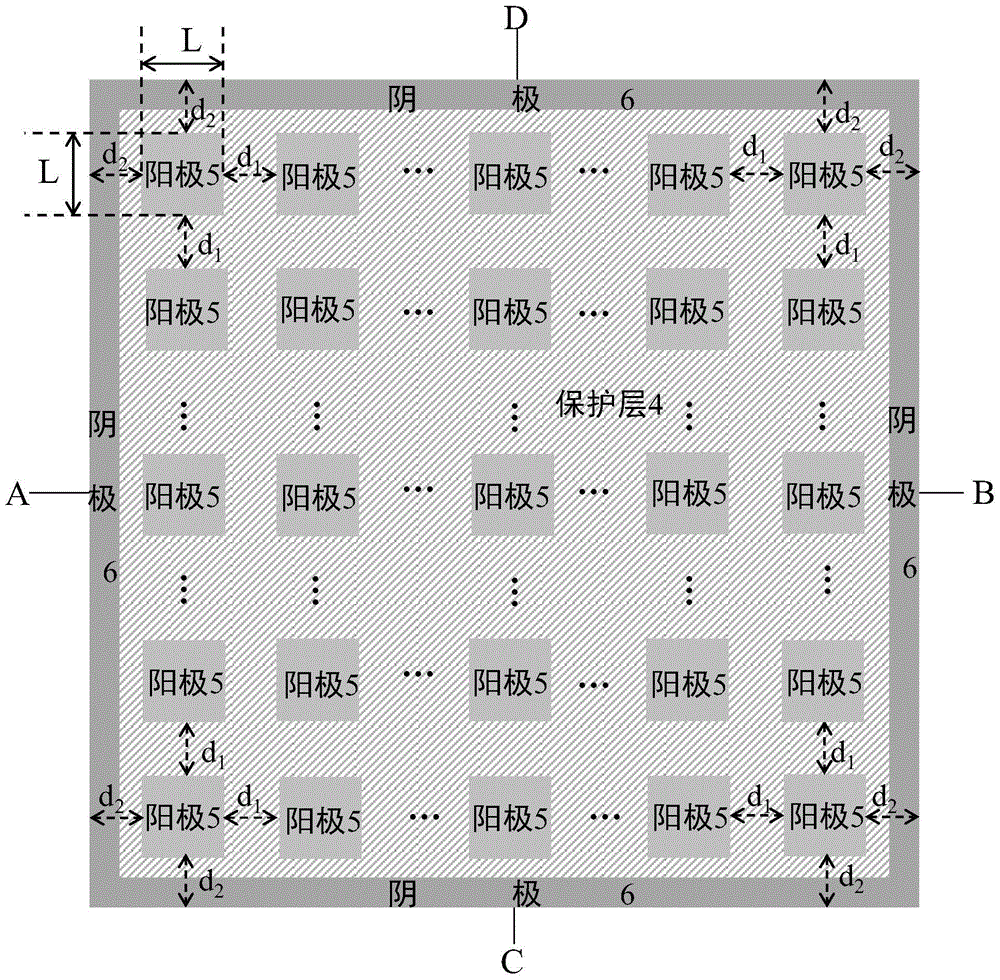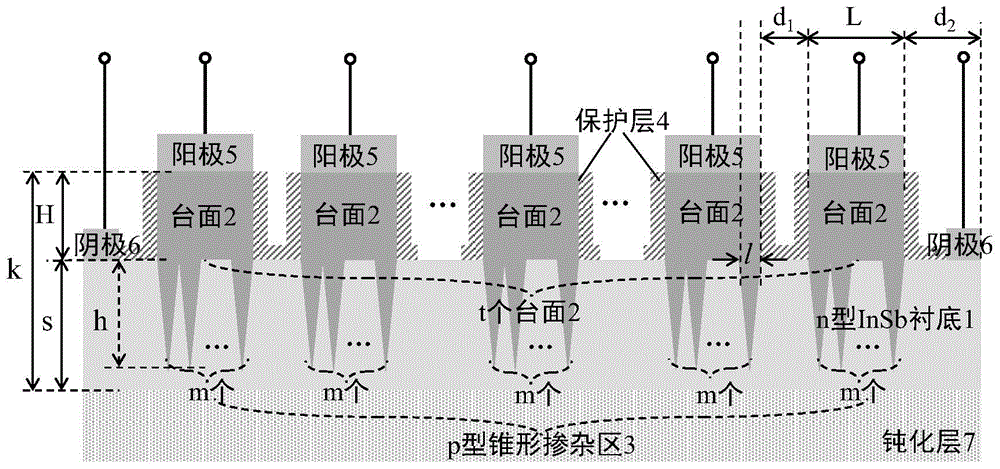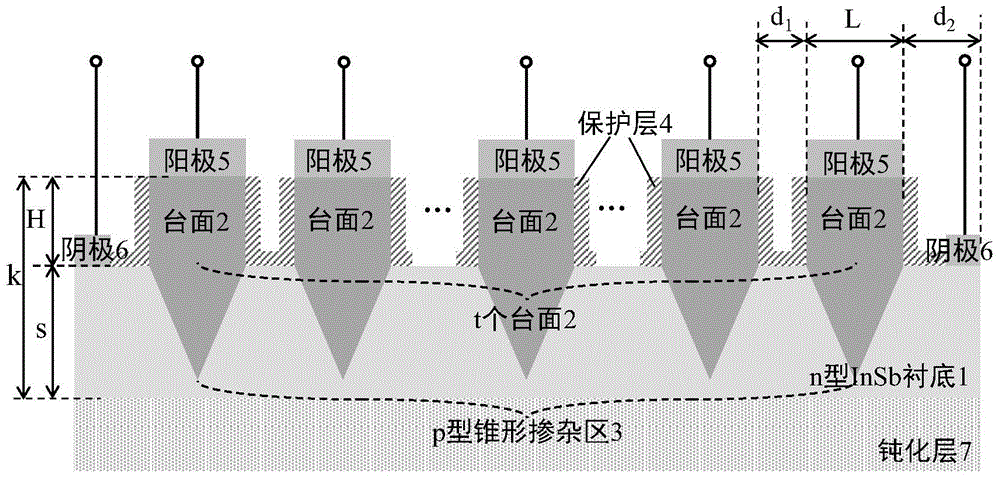Photovoltaic detector array and manufacturing method thereof
A detector array, photovoltaic type technology, applied in the direction of photovoltaic power generation, semiconductor devices, electrical components, etc., can solve the problems that affect the generation of photogenerated carriers and the difficulty of realization, so as to enhance the ability, improve the quantum efficiency, and increase the junction density. area effect
- Summary
- Abstract
- Description
- Claims
- Application Information
AI Technical Summary
Problems solved by technology
Method used
Image
Examples
Embodiment 1
[0039] Embodiment 1: The protective layer is SiN, the passivation layer is SiN, the number of p-type conical doped regions directly below each mesa is m=4, and the array size is 50×50 photovoltaic detector arrays.
[0040] Step 1, etching and manufacturing 50×50 mesas 2 on the n-type InSb substrate 1, such as Figure 5 a.
[0041] 1a) At a thickness k of 22 μm and a doping concentration of 1×10 16 cm -3 For the first time, a mask is made on the n-type InSb substrate 1. The mask pattern is an array of 50×50 squares whose side length L is 52 μm. The distance between two adjacent squares is d 1 , and the distance d between the most edge square and the edge of n-type InSb substrate 1 2 Both are 50μm;
[0042] 1b) Use the mask to etch 50×50 mesas 2 on the n-type InSb substrate 1 by reactive ion etching technology, where the height H of each mesa is 8 μm. After the n-type InSb substrate 1 is etched The thickness s is 14 μm. The process conditions used for etching the mesa are:...
Embodiment 2
[0068] Embodiment 2: Making the protective layer is SiO 2 , the passivation layer is SiO 2 , the number of p-type tapered doped regions directly under each mesa is m=2, and the array size is a photovoltaic detector array of 1024×1024.
[0069] Step 1, etching and manufacturing 1024×1024 mesas 2 on the n-type InSb substrate 1, such as Figure 5 a.
[0070] At a thickness k of 14 μm and a doping concentration of 1×10 14 cm -3 The n-type InSb substrate 1 made a mask for the first time, using inductively coupled plasma reactive etching technology, in Ar / CH 4 / H 2 Under the process conditions of a flow ratio of 1:3:10, a pressure of 15Pa, and a power of 600W, 1024×1024 mesa heights H of 4 μm were etched on the n-type InSb substrate 1, and the upper and lower surfaces were both square and A mesa 2 with a side length L of 30 μm, where the distance between two adjacent mesas is d 1 , the distance d between the edge of the mesa and the edge of the n-type InSb substrate 2 Both a...
Embodiment 3
[0087] Embodiment three: making protective layer is SiN, and passivation layer is SiO 2 , the number of p-type tapered doped regions directly below each mesa is m=1, and the array size is a photovoltaic detector array of 30000×30000.
[0088] Step A, etching and manufacturing 30000×30000 mesas 2 on the n-type InSb substrate 1, such as Figure 5 a.
[0089] At a thickness k of 4.4 μm and a doping concentration of 1×10 11 cm -3 For the first time, a mask was made on the n-type InSb substrate 1, and 30000×30000 square mesas 2 with a side length of 5 μm were etched on the n-type InSb substrate 1 by inductively coupled plasma reactive etching technology. The distance d between two tables 1 , the distance d between the edge of the mesa 2 and the edge of the n-type InSb substrate 1 2 Both are 1 μm, the height H of each mesa is 0.4 μm, and the thickness s of the n-type InSb substrate 1 after etching is 4 μm. The process conditions for etching the mesa are: Ar / CH 4 / H 2 The flo...
PUM
 Login to View More
Login to View More Abstract
Description
Claims
Application Information
 Login to View More
Login to View More - R&D
- Intellectual Property
- Life Sciences
- Materials
- Tech Scout
- Unparalleled Data Quality
- Higher Quality Content
- 60% Fewer Hallucinations
Browse by: Latest US Patents, China's latest patents, Technical Efficacy Thesaurus, Application Domain, Technology Topic, Popular Technical Reports.
© 2025 PatSnap. All rights reserved.Legal|Privacy policy|Modern Slavery Act Transparency Statement|Sitemap|About US| Contact US: help@patsnap.com



